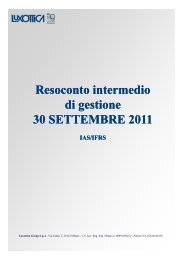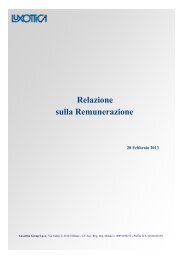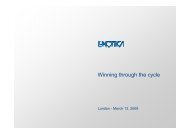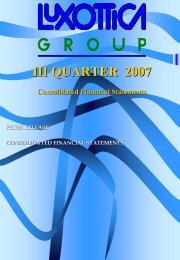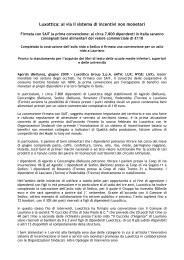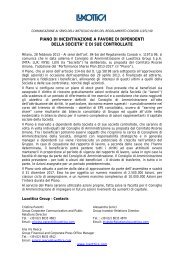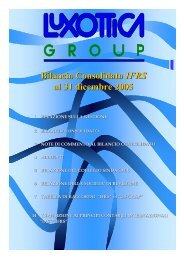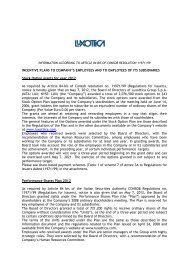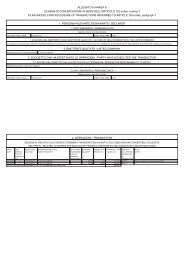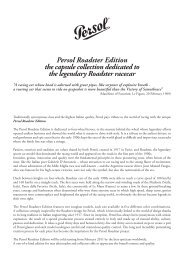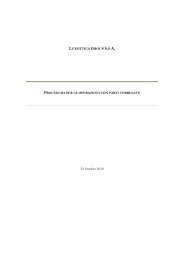Annual Review 2012 - Luxottica
Annual Review 2012 - Luxottica
Annual Review 2012 - Luxottica
You also want an ePaper? Increase the reach of your titles
YUMPU automatically turns print PDFs into web optimized ePapers that Google loves.
2.2 MISSION AND STRATEGY<br />
19<br />
development of its manufacturing capacity, it started to pursue a strategy of vertical<br />
integration, with the goal of distributing frames directly to the market. The first step was<br />
the acquisition of Scarrone S.p.A., which had marketed the Company’s products since 1971<br />
bringing with it a vital knowledge of the Italian eyewear market.<br />
<strong>Luxottica</strong>’s international expansion began in the 1980s with the acquisition of independent<br />
distributors and the formation of subsidiaries and joint ventures in key international<br />
markets.<br />
<strong>Luxottica</strong>’s wholesale distribution expansion has focused on customer differentiation,<br />
customized service and new sales channels, such as large department stores, travel retail<br />
and e-commerce, as well as penetration in the emerging markets.<br />
> Eyewear, a new frontier of fashion: the acquisition of La Meccanoptica<br />
Leonardo in 1981, the owner of the Sferoflex brand and an important flexible hinge patent,<br />
enabled the Company to enhance the image and quality of its products and increase its<br />
market share.<br />
From the late 1980s, eyeglasses, previously perceived as mere sight-correcting instruments,<br />
began to evolve into “eyewear.” Continual aesthetic focus on everyday objects and<br />
designers’ interest in the emerging accessories industry led <strong>Luxottica</strong> to embark on its first<br />
collaboration with the fashion industry in 1988 by entering into a licensing agreement with<br />
Giorgio Armani. The Company followed up that initial collaboration with numerous others<br />
and with the acquisition of new brands, gradually building the current world-class brand<br />
portfolio and thereby increasing its commitment to research, innovation, product quality<br />
and manufacturing excellence.<br />
Over the years <strong>Luxottica</strong> has launched collections from names like Bulgari (1997), Chanel<br />
(1999), Prada (2003), Versace (2003), Donna Karan (2005), Dolce & Gabbana (2006), Burberry<br />
(2006), Polo Ralph Lauren (2007), Tiffany (2008), Stella McCartney (2009), Tory Burch (2009),<br />
Coach (<strong>2012</strong>) and Armani (2013).<br />
In addition, <strong>Luxottica</strong> acquired Ray-Ban in 1999, one of the world’s best-known sunglasses<br />
brands. Through this acquisition, the Company obtained crystal sun lens technology as<br />
well as the associated manufacturing capacity and added to its portfolio the Arnette,<br />
REVO and Killer Loop brands.<br />
In 2007, <strong>Luxottica</strong> acquired California-based Oakley, a leading sport and performance<br />
brand, which owned the Oliver Peoples brand and a license to manufacture and distribute<br />
eyewear under the Paul Smith name. Oakley also had its own retail network at the time of<br />
over 160 stores.<br />
In the first quarter of 2013, <strong>Luxottica</strong> acquired Alain Mikli International, a French luxury<br />
and contemporary eyewear company, which owns the Alain Mikli brand and the Starck<br />
Eyes license. As a result, <strong>Luxottica</strong> will strengthen both its luxury brand portfolio and<br />
prescription offerings, which now include Alain Mikli’s distinctive designs.<br />
> Expansion in retail distribution: in 1995, <strong>Luxottica</strong> acquired the United States<br />
Shoe Corporation, which owned LensCrafters, one of North America’s largest optical retail



